Читать книгу The Religion and Folklore of Northern India - William Crooke - Страница 77
На сайте Литреса книга снята с продажи.
Оглавление1 Atkinson, “Himâlayan Gazetteer,” ii. 762.
2 Cunningham, “Archæological Reports,” xvii. 141.
3 Barth, “Religions of India,” 265.
4 Gubernatis, “Zoological Mythology,” ii. 99 sq.
5 See instances collected by Tylor, “Primitive Culture,” i. 376 sqq.
6 “Asiatic Studies,” 13 sq.
7 Buchanan, “Eastern India,” i. 467; Dalton, “Descriptive Ethnology,” 147.
8 Campbell, “Notes,” 260.
9 “Legend of Perseus,” i. 173.
10 “Descriptive Ethnology,” 140.
11 “Journey through Oudh,” ii. 133.
12 Campbell, “Notes,” 260.
13 Buchanan, “Eastern India,” ii. 141 sq.; “Panjâb Notes and Queries,” iv. 9.
14 Dowson, “Classical Dictionary,” s.v.
15 “Gazetteer,” 323.
16 “Papers,” 16.
17 Ibid., 23 sq.
18 Madden, “Journal Asiatic Society Bengal,” 1848, p. 600; Hunt, “Popular Romances,” 73.
19 Buchanan, “Eastern India,” iii. 38.
20 Frazer, “Golden Bough,” ii. 225 sqq.; “Panjâb Notes and Queries,” iii. 181 sq.
21 Knowles, “Folk-tales from Kashmîr,” 10.
22 “Original Inhabitants,” 455.
23 “Central India,” ii. 206.
24 Tod, “Annals,” i. 67; for other examples see Buchanan, “Eastern India,” ii. 131, 352, 478; “Central Provinces Gazetteer,” 110.
25 “Panjâb Ethnography,” 114.
26 Frazer, “Golden Bough,” ii. 83.
27 Tawney, “Katha Sarit Sâgara,” i. 8.
28 “Bombay Gazetteer,” iii. 220; “Râjputâna Gazetteer,” iii. 65.
29 Gomme, “Ethnology in Folk-lore,” 34 sq.
30 Frazer “Golden Bough,” ii. 233.
31 “Bhandâra Settlement Report,” 51.
32 Ganga Datt Upreti, “Folk-lore of Kumaun,” Introduction, vii.
33 Dalton, “Descriptive Ethnology,” 220, 281.
34 “Settlement Report,” 257.
35 Dalton, “Descriptive Ethnology,” 268.
36 Risley, “Tribes and Castes of Bengal,” ii. 58.
37 Temple, “Wideawake Stories,” 399.
38 Ibbetson, “Panjâb Ethnography,” 114; “Oudh Gazetteer,” i. 518.
39 Atkinson, “Himâlayan Gazetteer,” ii. 825.
40 Channing, “Settlement Report,” 34.
41 Maclagan, “Panjâb Census Report,” 103 sq.
42 Führer, “Monumental Antiquities,” 146.
43 Sir W. Scott, “Letters on Demonology,” 143.
44 Dalton, “Descriptive Ethnology,” 147.
45 Wilson, “Essays,” i. 21; “Bombay Gazetteer,” xvi. 568.
46 Jarrett, “Aîn-i-Akbari,” ii. 159; Führer, “Monumental Antiquities,” 153.
47 “Annals,” ii. 15.
48 “Notes,” 147.
49 MacIagan, “Panjâb Census Report,” 107.
50 Sherring, “Sacred City,” 119.
51 “Panjâb Notes and Queries,” i. 35.
52 “Central Provinces Gazetteer,” 259.
53 For the Celtic Mothers see Rhys, “Lectures,” 100, 899; for Arabia, Robertson-Smith, “Kinship,” 179.
54 Lubbock, “Origin of Civilization,” 146; Starke, “Primitive Family,” 17 sqq.; Letourneau, “Sociology,” 384.
55 Benfey, “Panchatantra,” i. 41–52; quoted by Tawney, “Katha Sarit Sâgara,” ii. 638.
56 Monier-Williams, “Sanskrit Dictionary, s.v. Mâtrî”; for the Nepâl enumeration, Oldfield, “Sketches,” i. 151; for Bombay, “Gazetteer,” xvii. 715. In the “Katha Sarit Sâgara” (i. 552), Nârâyanî is their leader. There is a very remarkable story of the gambler who swindled the Divine Mothers (ibid., ii. 574 sqq.).
57 Campbell, “Notes,” 311; “Athenæum,” 6th December, 1879; “Folk-lore Record,” iii. Part i. 117 sqq.
58 “Bombay Gazetteer,” v. 432 sq.
59 Atkinson, “Himâlayan Gazetteer,” ii. 884.
60 Cunningham, “Archæological Reports,” vii. 158.
61 Growse, “Mathura,” 116, 125; Führer, “Monumental Antiquities,” 27, 132.
62 Bholanâth Chandra, “Travels of a Hindu,” i. 38.
63 “Rig Veda,” viii. 23, 25.
64 Brand, “Observations,” 331.
65 “Border Minstrelsy,” 466.
66 Tod, “Annals,” ii. 363 sq., 763; Conway, “Demonology,” i. 54.
67 Campbell, “Notes,” 145.
68 Tod, “Annals,” i. 708; ii. 670.
69 Hartland, “Legend of Perseus,” i. chap. iv.
70 Dalton, “Descriptive Ethnology,” 232.
71 “Gazetteer,” 276.
72 “Rambles and Recollections,” i. 123.
73 Stokes, “Indian Fairy Tales,” 140 sqq.; Temple, “Wideawake Stories,” 109, 302; “Indian Antiquary,” iv. 57; Grimm, “Household Tales,” ii. 400.
74 Dalton, “Descriptive Ethnology,” 64; other instances in Westermarck, “History of Human Marriage,” 158 sq.
